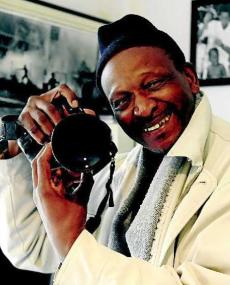
Bongani Mnguni was a South African photographer and photojournalist who dedicated his life to exposing the brutality of the apartheid system.
Mnguni was born in Soweto on the 18th of November in 1953. He attended and matriculated at Orlando High School in Soweto. His interest in photography began in the early 1960's.
Bongani started out as a freelance photographer in 1972 and used his camera as a tool to capture pictures and family portraits. His work was a reflection of the history of many South Africans, telling the stories of black people during the apartheid era. He captured eye-catching and award-winning images for publications he worked for, including The World, Sowetan and Sunday World.
Mnguni was one of many that had to endure the torture of apartheid police. He was beaten up, harassed and almost buried alive. However, this never obstructed him from risking his life to capture history as it unfolded.
On the morning of June 16 1976, Mnguni left his home in Orlando West to walk his daughter to school in the same neighbourhood. He soon realised that high school pupils had embarked on a strike. He took his daughter back home and armed himself with his cameras, sensing that there was something unbecoming brewing.He had heard previously that the pupils were planning to march to Orlando Stadium to protest against the use of Afrikaans as a medium of instruction in black schools. He was then a staff photographer at The World, a newspaper targeting the country's black population.
So that morning, Mnguni did what any news photographer in search of a good story would do. He joined the group of pupils, chanting and singing in the streets, waiting to see what would unfold. What he captured that day would later become part of SA's history.
Mnguni's archive of black and white negatives, photographs and colour pictures bears testimony to his role as a witness to SA's transition from an oppressive police state to a constitutional democracy.
Besides photographing the 1976 Soweto uprisings, Mnguni's camera also captured the daily struggles of ordinary people throughout the difficult years of apartheid.
And when Nelson Mandela was sworn in as president, who else was there to capture the transition but the bald one himself, Mnguni.
His office at his home is like a museum to the country's turbulent history. The drawers and cabinets are full of photographs of the bullet riddled bodies of MK guerillas, shot by apartheid police during the 1980 siege of Silverton; of militant youths carrying coffins draped in the colours of the then banned ANC and SACP during mass funerals in the townships; of people with no names, their bodies reduced to ashes and rubble by a burning laced with petrol and put over their heads.
Mnguni's burning wish at the time of his death was to exhibit his work at galleries and museums of the world, to tell the world through his photographs, the story of the country he loved with every drop of the blood that flowed in his veins.
However, capturing the events of the Struggle did not draw him away from his passion for boxing. His father Puncho "Villa" Mnguni was a professional boxer, and he too dabbled in the fistic sport which he later spent many hours photographing.
Mnguni also has an impressive collection of the game of the masses, football, memorable cup finals, ordinary league matches and derbies. Bongani would also use his camera to photograph the lighter side of life - dances in the townships and parties.
In 1977, Mnguni forced his way into a mass funeral of police victims in Soweto. The press corps had been warned to stay away or face the consequences by the comrades. The police, fearing that their brutality would reach the outside world, considered journalists the enemy too, and banned them from such events.
And so, Mnguni was spotted taking photographs. "I was beaten up by those youths. They threw me into the grave and started throwing soil on top of me, burying me alive. But one of the youths who had seen me taking pictures in the township intervened and saved me. That's how I survived," Mnguni told Mukurukuru Media editor Lucas Ledwaba in an interview.
Mnguni spent time in France in the late 1980s, exhibiting his images to Europeans who had only just heard snippets of the violence in SA.
Sunday World editor Mapula Nkosi said she got to know Mnguni when he took over the City Press pictures' desk after ntate Mike Mzileni had left.
"Before that his reputation as one of the journalists who captured the June 16 riots had been known to me as he always offered his insights during the commemorations," Nkosi recalled. "He was a man with a steely quiet strength, who was easy to laugh and would draw you with his soft but firm tone..."
Part of Mnguni’s 1976 work still features in a permanent exhibition at Regina Mundi Catholic Church in Soweto; some at the Hector Petersen Museum; and others were also showcased during the exhibition to commemorate the 40th anniversary of the Soweto uprisings in 2016.
Mnguni passed away on the 14th of April 2019, and is survived by his wife and seven children.